Perspecta Stereophonic Sound | Read more at in70mm.com The 70mm Newsletter |
| Written by: CHARLES J. BACHMAN, Theatre Equipment Products Mgr. Fairchild Recording Equipment Co. Published in THEATRE CATALOG 1954-55 | Date: 20.05.2024 |
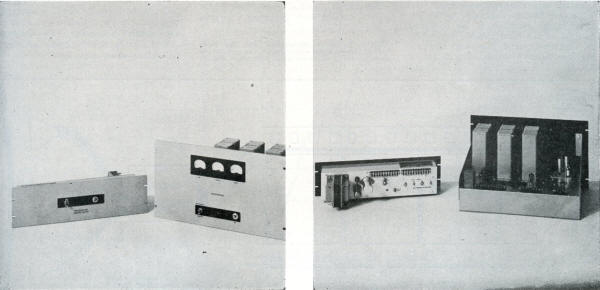 A FRONT (left) and rear (right) view of the power supply and integrator unit necessary in order to obtain the optical stereophonic sound. A FRONT (left) and rear (right) view of the power supply and integrator unit necessary in order to obtain the optical stereophonic sound.
Stereophonic sound can now be recorded on and reproduced from a single optical track of any existing variety. In fact, during the past several months, hundreds of theatres have been equipped to show film with stereophonic sound recorded by this method. This accomplishment, Perspecta Stereophonic Sound, is the result of an idea conceived by C. Robert Fine and the development of the practical equipment by Fairchild Recording Equipment Company, under the direction of Ray F. Crews. The system was quickly accepted by the motion picture industry's major producers as the standard for stereophonic sound. | More in 70mm reading: Perspecta Sound and the Fairchild Perspecta Integrator Perspecta stereophonic sound by Stelma Electronics The Paramount VistaVision Process in70mm.com's page about VistaVision in70mm.com News Peripheral Vision, Scopes, Dimensions and Panoramas in70mm.com's Library Presented on the big screen in 7OMM 7OMM and Cinema Across the World Now showing in 70mm in a theatre near you! 70mm Retro - Festivals and Screenings |
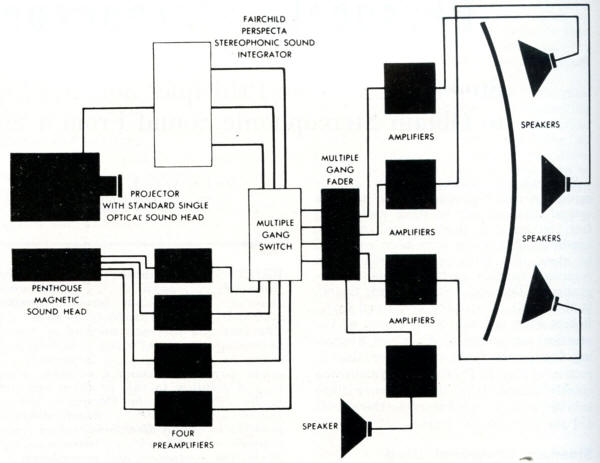 THIS DIAGRAM illustrates what a theatre operator must do to install Perspecta stereophonic sound if the theatre is already equipped for a magnetic track system. The only equipment needed is one integrator unit and a transfer switch. The black symbols seen represent existing equipment. THIS DIAGRAM illustrates what a theatre operator must do to install Perspecta stereophonic sound if the theatre is already equipped for a magnetic track system. The only equipment needed is one integrator unit and a transfer switch. The black symbols seen represent existing equipment.How Perspecta Works In the actual reproduction of stereophonic sound, the audience is conscious primarily of the difference in sound intensity from different directions. For example, when a voice originates near the left side of the screen, it is identified as coming from the left only because it is louder from the left speaker than sound emanating from the center and right speakers. The Perspecta sound method of recording is particularly adaptable to accentuation of the volume difference effect between speakers. As a result, the most startling and spectacular effects can be realized. To understand the basic concept of Perspecta sound, one must first remember that standard theatre sound equipment reproduces sound audible to the audience between approximately 70 and 8,000 cycles. The heart of the Perspecta sound system, then, is a specially-designed unit called an integrator, which accepts all sound on the optical track and then does two things: first, it separates the whole recording into two sections, one being the true audio of the program material from 63 cycles upward, and the other being control frequencies which are below 63 cycles. The control frequencies are then separated by band-pass filters, with the result that a separate control voltage is supplied to each of the individual circuits feeding the three theatre channels. Thus, these control frequencies present on the Perspecta sound track accurately govern the distribution of sound to the three theatre horn systems. To be specific, let's assume that the action and sound on the left side of the stage is to be accentuated. The studio mixer raises the volume of the 30-cycle control signal being recorded and reduces the volume of the 35- and 40-cycle carriers by the desired amounts. As the action and sound move to the center of the stage, the volume of the 35-cycle carrier is raised and the 30-cycle (left) and 40-cycle (right) carrier signals are reduced. Of course, any combination of levels can be obtained to give the impression the sound is coming from any intermediate location on the screen. It also is possible to raise all carriers to full output at the same time. | |
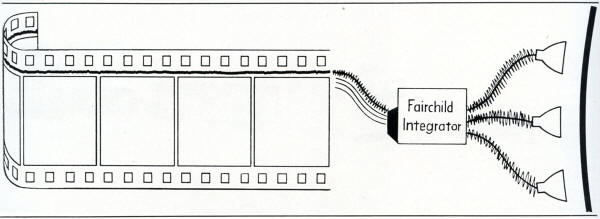 THIS is Perspecta stereophonic film. The three low-frequency tones which govern the sound have been recorded on same track with other sounds. THIS is Perspecta stereophonic film. The three low-frequency tones which govern the sound have been recorded on same track with other sounds.In practice, the recording is made in the conventional manner and volume variation is accomplished by including the three low-level, low-frequency carrier signals on the same track with the speech and music. When played through a standard, single-channel optical sound system, these carrier tones are inaudible. Because of this, the Perspecta release print will play as single sound in any theatre in the world. However, the same Perspecta release print will produce the finest stereophonic sound in a theatre equipped with the Fairchild Perspecta Integrator and multiple speakers and amplifiers. Installation Considerations To install the integrator, it is necessary only to connect the output of the projectors to the input of the integrator at a point past the changeover position. Only one integrator is used in a projection booth. A selection of input impedances is available so that low-impedance (500 ohm) and high-impedance sound head outputs are accommodated by a preamplifier with a wide range of gain. The output impedance of the three channels is 600 ohms for connection to the input of the three theatre power amplifiers. A three-gang, 600-ohm, 20-step volume control is then inserted at the output of the integrator to control the auditorium sound level. No changes whatsoever are made to the projectors. The film carries normal-sized sprocket holes, thus requiring no special splicing machine. This film is not subject to the hazards of magnetic-type recording, as it is not affected by heavy AC fields nor subject to easy abrasion. Hum troubles are at a minimum because the system operates with lower gain than the magnetic-type recording. | |
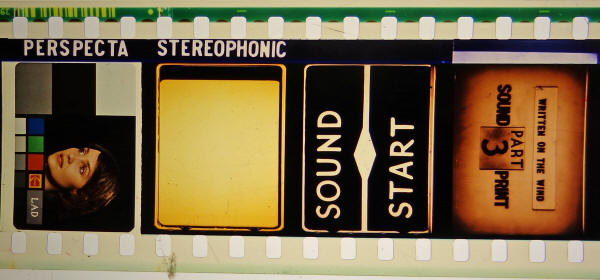 The Perspecta directional (control) tones continued to exist on prints made in later years. They could show up many years later, as seen on this sample from a newer print of a 1956 movie being inspected in 2013. Image: Paul Rayton The Perspecta directional (control) tones continued to exist on prints made in later years. They could show up many years later, as seen on this sample from a newer print of a 1956 movie being inspected in 2013. Image: Paul RaytonAnother feature noticeable to the listener is the quietness of the no-signal sections of the picture being presented. In Perspecta sound recording there is only one track to contend with so far as signal-to-noise ratio is concerned, where-as in multitrack systems all channels are open, whether carrying sound or not. With the Perspecta Integrator in operation each channel is closed except during the actual transmission of sound. From Projectionist's Standpoint Perspecta sound presents no novel procedures to learn. The same film is used as in the past; the same method of threading, and the same old splicer familiar to all projectionists. The motor-operated, enclosed rewinder may be used as usual, and the film can be located without harm near motors or rectifiers. With the integrator, it is possible to run not only stereophonic prints but also conventional optical non-stereophonic prints without even throwing a switch. This ease of operation is accomplished by an automatic switching arrangement built into the integrator. When a single-optical-track film is being run, this switch moves to the "mono-sound" position and the sound comes out through center horns only. When a Perspecta-sound-track film is being run, the switch moves automatically to the "Perspecta sound" position and the sound enters each horn as originally planned by the sound recording studio. Maintenance of the unit is quite elementary, as the equipment has been thoroughly designed following conventional practices. The unit has good accessibility for maintenance purposes. Compatibility with existing equipment and method is an outstanding advantage of Perspecta Stereophonic Sound system. Comparative simplicity of the integrator and the entire system keeps installation and maintenance costs low. | |
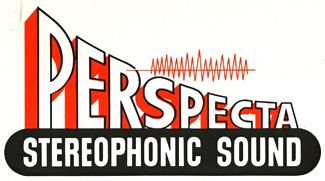 • Go to Perspecta Stereophonic Sound | |
| Go: back - top - back issues - news index Updated 31-03-25 |
